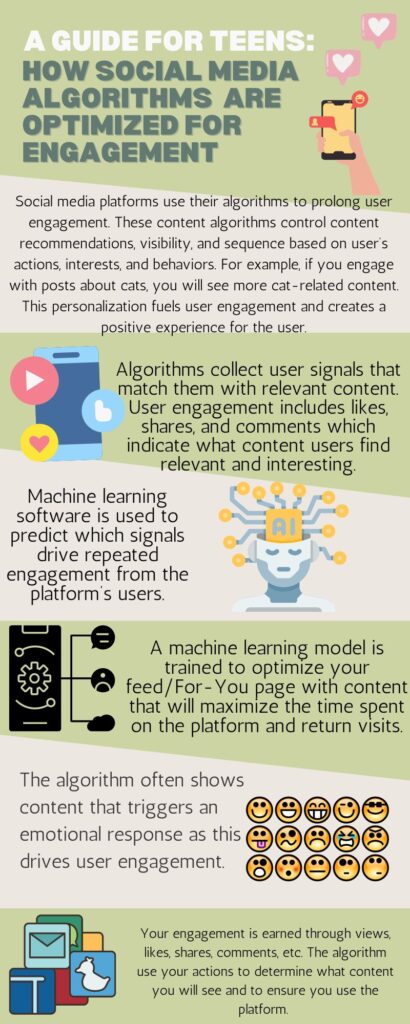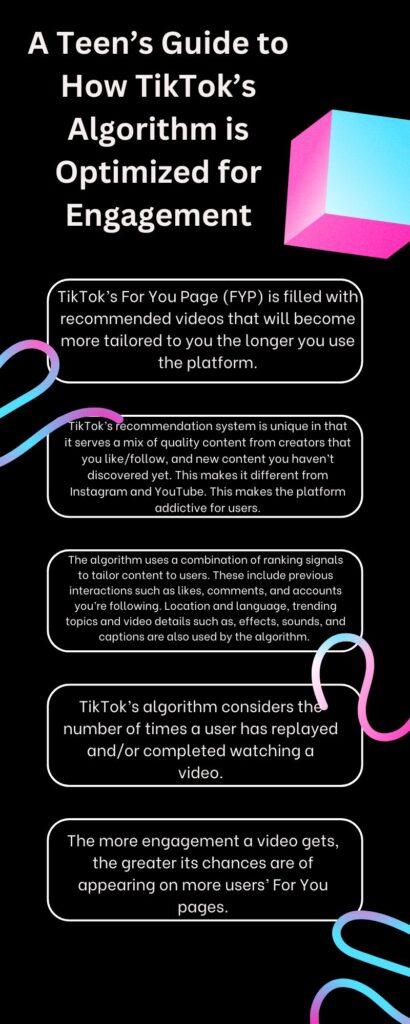
For my misinformation education activity, I’ve chosen to explain how an aspect of digital technology works to a specific audience. The topic I’m covering and teaching my audience about is how social media algorithms are optimized for engagement. This topic is important because social media algorithms being optimized for engagement play a big role in why social media is addictive. The way these algorithms are constructed is also why we see certain content but not others.
My target audience is teenagers of all genders aged 13-17. I’ve chosen this age range because social media companies require that children be at least 13 years old to create an account. This complies with the Children’s Online Privacy Protection Act (COPPA).
Social media is extremely popular with teenagers, and I think that many of them aren’t educated on how the algorithms work and how they are designed for constant engagement. Knowing this information could help teenagers be aware of how this makes social media addictive and affects what content they do and don’t see.
I created two infographics on Canva that explain how social media algorithms are optimized for engagement. As a visual learner myself, I find infographics to be useful in how they break down information in an organized way that is visually appealing to look at/read. An example of this that I took inspiration from is an infographic from the Cornell University Library that explains how to spot fake news.
An infographic can also be effective as it can be shared on social media platforms. Since there’s a limited amount of space on an infographic, I included the information I thought was most important for my audience to know. I will provide more background context in this blog post.
Social media algorithms are optimized for engagement as the algorithm is trained to recommend content that is like what the user has interacted with. An article from Sprout Social explains that social media algorithms use signals, data, and rules to control the platform’s operation. The algorithm determines how content is selected, filtered, ranked, and recommended to users.
Sprout Social explains how the algorithms match users with relevant content by collecting user engagement signals such as likes, comments, and shares. These actions tell the platform what content a user finds interesting and relevant. The algorithms are AI-driven and filter content for users “based on explicit (follows and likes) and implicit (video-watching time) details to personalize content recommendations.”
The first infographic I created (above) is a guide for teenagers on how social media algorithms are optimized for engagement. Every social media platform has its unique algorithm that we only know so much about. This is because social media companies often keep the details of their algorithms secret. After all, they consider it to be the ‘secret sauce’ of their business.
Even though each of the platform’s algorithms is different, they generally work the same way. An article from Hoot Suite explains how all the algorithms use and are based on machine learning and a set of factors called ranking signals. These signals rank every piece of content’s value for each user at a certain point in time.
Despite using advanced technological systems, their overall function is to “scan the entire pool of content available, then score and rank it to determine what appears in a user’s feed.” All social media algorithms view liking, commenting, or sharing a piece of content to be positive signals of what a user wants to see. Negative signals including stopping a video, blocking and/or hiding a post, are used by the algorithm to indicate what a user does not want to see as explained in an article by Quick Frame.
For my second infographic (below), I focused on one social media platform. I chose to specifically use this infographic to educate teens on how TikTok’s algorithm is optimized for user engagement. A study from Statista found that TikTok was used by 63% of U.S. teens aged 13-17 (my target audience) in 2023.
I also chose TikTok for the second infographic because as described in an article by Buffer, its algorithm is different compared to other platforms such as YouTube and Instagram. Its recommendation system serves up a mix of quality content by creators the user follows as well as new content. This has helped give TikTok its addictive characteristics.
By educating teens about social media algorithms and how they are optimized for engagement, they can have a better understanding of how this makes social media addictive and affects what they do and don’t see on their feeds. The more users engage with the platform, the better it is for the platform’s bottom line.

Resources Used For Infographics: